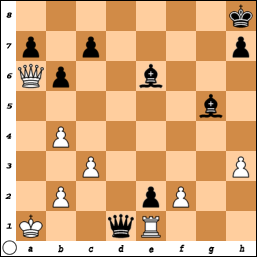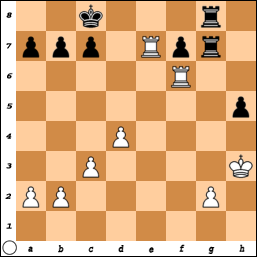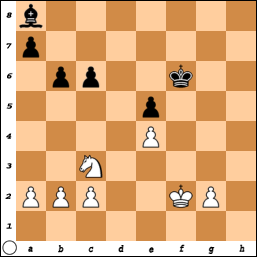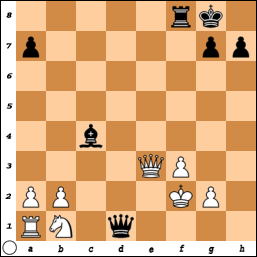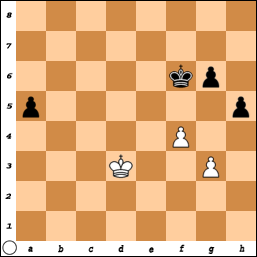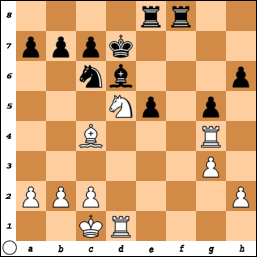Philidor Counter Gambit
This game was played at the New
Jersey Open in 2008. I eventually went on to win the tournament although the
games were definitely not easy! In particular I remember feeling that this
game was "surprisingly difficult" (as I said to Jim after the game)
considering it was played in an opening that is supposed to give White a large
advantage.
1.e4 e5 2.Nf3 d6 3.d4 f5
This is the Philidor Counter Gambit.
It was favored by some of the all time greats like Philidor and Morphy but
doesn't see much action in today's games. At the time, I knew that Jim was a
big proponent of this variation and after spending a bit of time looking for
an idea against it, I decided to try out the line played in the game.
4.Nc3
fxe4 5.Nxe4 d5
5... Nf6. According to the computer this move is Black's best
option here and gives the following line as a sample of how the game can
continue: 6.Bg5 Be7 7.Bxf6 Bxf6 8.Bc4.
6.Nxe5
6.Neg5!? This is
another interesting continuation. The most important detail here is to know
that the move 6...h6 puts Black in serious hot water. 6...e4 (6... h6? 7.Nf7! +- 8.Kxf7 8.Nxe5+. Black loses too much material or gets mated here.) 7.Ne5, This is also very strong for White.
6...dxe4 7.Qh5+ g6 8.Nxg6
The game
starts with a bunch of fireworks in the opening, However, the following
sequence is almost entirely forced for both players, and I think we both had a
sense of how this line is played.
8...Nf6 9.Qe5+ Kf7 10.Bc4+ Kg7 11.Bh6+ Kxh6
It's not every day that the king makes it out to the 6th rank in the opening! This is certainly a very provocative king walk. Objectively, White should be
doing well in this position. White needs to make sure not to give Black any
time to complete development or start centralizing with tempo. If the Black
pieces get coordinated, they will be more powerful than White's rook and pawns
12.Nxh8 Bb4+ 13.c3 Qxh8 14.cxb4 Qf8 15.Qf4+ Kg6 16.Rc1!
A nice
multi-purpose move. The rook is ready to lift up to c3 and swing over to g3 if
given enough time. It helps to take the sting out of 16...Qxb4+ coming up.
16...Qxb4+
16...Qd6!? Perhaps this is Black's best defense, but it leaves Black in a
passive and unenviable position after 17.Qxd6 cxd6 18.Bf7+ Kxf7 19.Rxc8+-. The pin on the 8th rank is extremely uncomfortable and leaves Black
without great prospects to create counterplay.
17.Rc3! Bg4 18.h4!
Bringing another piece into the attack. The threat is of course
to play 19.Qg5 mate, but there are also ideas of flicking in the move h4-h5
discombobulating the Black kingside defenders.
18,,,h6!
18...h5!? According
to the computer this is about equally strong as 18...h6, but I could never see a
human playing this move, After 19.Qg5+, Black will lose the knight on f6 with no
chances.
19.h5+! Kg7
19... Bxh5?. This might look tempting, but Black's
king is defending too many things right now and will soon be overloaded. 20.
Rxh5! Kxh5 (20... Nxh5 21. Qf7+ Kg5 22. Be6! The mating net around the
Black king is too much to deal with. Mate will happen within the next few
moves: 21. Bf7#.
20.Rh4 Nc6 21.Qxc7+??
I made a big mistake with this
move. Looking back close to 15 years after the game was played, I can't really
understand what I didn't like about the proper continuation 21.Rxg4+. 21.Rxg4+! This move practically plays itself. The defenders are removed in front of
the Black king, and White's remaining pieces quickly rush the king. 21...Nxg4 22.Qxg4+ Kh8 23.Qg6 Qf8 24.Rg3. Perhaps I missed the
idea of Bf7 during the game. It is extremely powerful here. Once it's played, there is no stopping Qf6+ which will bring an end to the game.
21...Bd7 22. Qg3+ Kh8 23.Qg6 Nh7! 24.Bb3?
A few turns ago Black was nearly mated, but
now they are back in the game! 24.Qxh6! This was a better move. From h6
White's queen is able to return to d2 to help hold together the queenside and
center. 24...Qxb2 25.Qd2 Qxd2+ 26.Kxd2+-.
24...Rf8??
Black returns the
favor. 24... Qf8! +/-. This would have been a tough defense to crack. As
Black starts to coordinate and repel away the attackers, White's initiative
fades away. The computer suggests to go for the prosaic 25.Qf7 to head towards an
endgame. That would have been a difficult decision. It would have been easy to
operate under the impression that White still has attacking chances here.
25.
Rf4!
Using the weakness of the g8-square to activate White's rook to a
better square and bring another piece into the attack.
25...Nxd4 26.Rxf8+??
26.Rf7! I missed this move during the game. This would have ruined Black's
defenses. A sample continuation could be. 26...Rxf7 27.Qxf7 Nxb3 28.Qxd7 Nd4
29.a3! Once White breaks the pin, Rc8 will be a winning blow along the 8th
rank.
26...Qxf8 27.Qxe4 Nxb3 28.Rxb3 Bc6 29.Qe5+ Nf6
29... Qf6! This was the best way to establish a defensive setup. The knight is more
active on f6 once the queens are exchanged. 30.Qxf6+ Nxf6 31.Rb4+- Nxh5
32.Rh4 Nf6 33.Rxh6+ Kg7. White should be able to win this with the connected
kingside pawns, but there is still work to be done here.
30.Kf1 Kh7 31.Qf5+
Kh8 32.Re3 Nh7 33.Qxf8+
I'm going to keep the comments of the game pretty
light from here on out because it enters a more technical phase of the game.
33...Nxf8 34.f3 Kg7 35.g4 Kf6 36.Kf2 Nd7 37.Kg3 Ne5 38.f4 Nc4 39.Re2 Nd6 40.Kh4 Kf7 41.g5 Nf5+ 42.Kg4 Bd7 43.Rd2
43. Re5! Breaking the blockade
immediately was the best way to go.
43...Nd6+ 44.Kh4 Nf5+ 45.Kh3 Nd4+ 46.Kg3 Nf5+ 47.Kf2 Ke7 48.Rd5 Be6 49.Ra5 a6 50.Kf3 Kd6 51.gxh6 Nxh6 52.Ke4
Ng8 53.a3 Bb3 54.Kf5 Bc2+ 55.Kg5 Ke6 56.h6 Nf6 57.f5+ Kf7 58.Kf4 Bb3 59.Rc5 Ne8 60.Rc8 Ba4 61.Ke5
61.h7! This would have led to cute finish
after 81...Kg7 62.f6+ Kxh7 63.f7 Kg7 64.fxe8=Q Bxe8 65.Rxe8.
61...Bd7 62.Rb8 Bc6 63.h7 Kg7 64.f6+ Kxh7 65.f7, Black resigns.
I'm grateful to be able to look back
on a game like this and relive some of these interesting moments. It's nice to
play an opponent like Jim who plays lively openings and heads the game into a
hard fought struggle.


